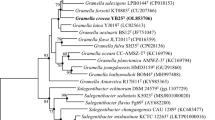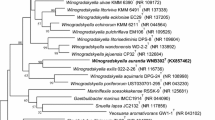Abstract
A non-motile, Gram-stain-negative, yellow pigmented, rod-shaped bacterium, strain HMD3159T, was isolated from a solar saltern in Korea. The major fatty acids were iso-C15:0 (26.3%), iso-C17:0 3OH (12.1%), iso-C16:0 (12.0%), summed feature 3 (comprising C16:1 ω7c and/or C16:1 ω6c; 11.0%) and summed feature 9 (iso-C17:1 ω9c and/or 10-methyl C16:0; 10.0%). The major respiratory quinone was MK-6. The DNA G+C content was 40.9 mol%. The phylogenetic tree based on 16S rRNA gene sequences showed that strain HMD3159T formed a lineage within the genus Gramella and closely related to Gramella gaetbulicola (95.5% sequence similarity), Gramella portivictoriae (94.9%), Gramella echinicola (94.6%), and Gramella marina (93.6%). On the basis of the evidence presented in this study, strain HMD3159T represents a novel species of the genus Gramella, for which the name Gramella jeungdoensis sp. nov., is proposed. The type strain is HMD3159T (=KCTC 32123T =CECT 7683T).
Similar content being viewed by others
References
Bernardet, J.F., M. Vancanneyt, O. Matte-Tailliez, L. Grisez, P. Tailliez, C. Bizet, M. Nowakowski, B. Kerouault, and J. Swings. 2005. Polyphasic study of Chryseobacterium strains isolated from diseased aquatic animals. Syst. Appl. Microbiol. 28, 640–660.
Cho, S., S. Chae, M. Cho, T. Kim, S. Choi, J. Han, Y. Kim, Y. Joung, K. Joh, O.I. Nedashkovskaya, and S.B. Kim. 2011. Gramella gaetbulicola sp. nov., a member of the family Flavobacteriaceae isolated from foreshore soil. Int. J. Syst. Evol. Microbiol. 61, 2654–2658.
Cho, J.C. and S.J. Giovannoni. 2003. Parvularcula bermudensis gen. nov., sp. nov., a marine bacterium that forms a deep branch in the alpha-Proteobacteria. Int. J. Syst. Evol. Microbiol. 53, 1031–1036.
Chun, J., J.H. Lee, Y. Jung, M. Kim, S. Kim, B.K. Kim, and Y.W. Lim. 2007. EzTaxon: a web-based tool for the identification of prokaryotes based on 16S ribosomal RNA gene sequences. Int. J. Syst. Evol. Microbiol. 57, 2259–2261.
Collins, M.D. 1985. 11 Analysis of isoprenoid quinones. In Methods in Microbiology, p. 329–366. T. Bergan (ed.), Academic Press, London, UK.
Felsenstein, J. 1981. Evolutionary trees from DNA sequences: a maximum likelihood approach. J. Mol. Evol. 17, 368–376.
Felsenstein, J. 1985. Confidence limits on phylogenies: An approach using the bootstrap. Evolution 39, 783.
Fitch, W.M. 1971. Toward defining the course of evolution: Minimum change for a specific tree topology. Syst. Zool. 20, 406.
Lau, S.C., M.M. Tsoi, X. Li, I. Plakhotnikova, S. Dobretsov, P.K. Wong, and P.Y. Qian. 2005. Gramella portivictoriae sp. nov., a novel member of the family Flavobacteriaceae isolated from marine sediment. Int. J. Syst. Evol. Microbiol. 55, 2497–2500.
MacFaddin, J.F. 1980 Biochemical Tests for Identification of Medical Bacteria, 2nd ed. Lippincott Williams & Wilkins Co., Baltimore, Maryland, USA.
Mesbah, M. and W.B. Whitman. 1989. Measurement of deoxyguanosine/thymidine ratios in complex mixtures by high-performance liquid chromatography for determination of the mole percentage guanine+cytosine of DNA. J. Chromatog. 479, 297–306.
Minnikin, D.E., A.G. O’Donnell, M. Goodfellow, G. Alderson, M. Athalye, A. Schaal, and J.H. Parlett. 1984. An integrated procedure for the extraction of bacterial isoprenoid quinones and polar lipids. J. Microbiol. Methods 2, 233–241.
Nedashkovskaya, O.I., S.B. Kim, and K.S. Bae. 2010. Gramella marina sp. nov., isolated from the sea urchin Strongylocentrotus intermedius. Int. J. Syst. Evol. Microbiol. Article in press.
Nedashkovskaya, O.I., S.B. Kim, A.M. Lysenko, G.M. Frolova, V.V. Mikhailov, K.S. Bae, D.H. Lee, and I.S. Kim. 2005. Gramella echinicola gen. nov., sp. nov., a novel halophilic bacterium of the family Flavobacteriaceae isolated from the sea urchin Strongylocentrotus intermedius. Int. J. Syst. Evol. Microbiol. 55, 391–394.
Saitou, N. and M. Nei. 1987. The neighbor-joining method: a new method for reconstructing phylogenetic trees. Mol. Biol. Evol. 4, 406–425.
Tamura, K., J. Dudley, M. Nei, and S. Kumar. 2007. MEGA4: Molecular Evolutionary Genetics Analysis (MEGA) software version 4.0. Mol. Biol. Evol. 24, 1596–1599.
Wayne, L.G., D.J. Brenner, R.R. Colwell, and O. Grimont. 1987. International Committee on Systematic Bacteriology. Report of the ad hoc committee on reconciliation of approaches to bacterial systematic. Int. J. Syst. Evol. Microbiol. 37, 463–464.
Author information
Authors and Affiliations
Corresponding author
Rights and permissions
About this article
Cite this article
Joung, Y., Kim, H., Jang, T. et al. Gramella jeungdoensis sp. nov., isolated from a solar saltern in Korea. J Microbiol. 49, 1022–1026 (2011). https://doi.org/10.1007/s12275-011-1192-0
Received:
Accepted:
Published:
Issue Date:
DOI: https://doi.org/10.1007/s12275-011-1192-0




